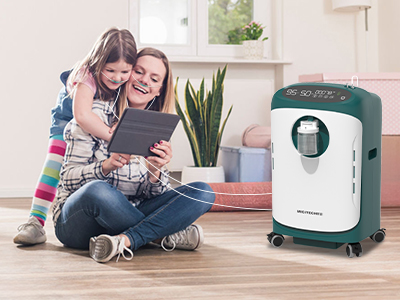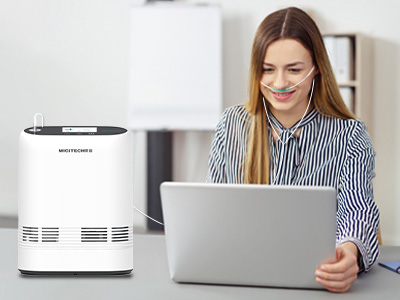11 Nov 2024
For individuals on oxygen therapy, physical exercise may seem daunting. However, with the support of an oxygen concentrator, physical activity becomes not only possible but also beneficial. Exercise has numerous advantages, from improving cardiovascular health to enhancing mental well-being. An oxygen concentrator can provide the necessary support to maintain safe oxygen levels while engaging in moderate physical activity, making exercise a manageable and even enjoyable endeavor.

Understanding the Role of Oxygen in Physical Activity
Oxygen plays a pivotal role in energy production within the body. During exercise, the muscles require a higher oxygen supply to generate energy efficiently and prevent fatigue. Oxygen supports cellular respiration, which powers muscle contractions and allows for sustained physical movement. For individuals with compromised lung function, maintaining adequate oxygen levels during exercise ensures that they can perform activities with reduced risk of breathlessness and fatigue, allowing them to benefit from the physical and mental rewards of an active lifestyle.
Consulting Your Healthcare Provider Before Starting
Before embarking on any exercise regimen with an oxygen concentrator, it’s essential to consult a healthcare provider. Medical professionals can assess individual needs and provide tailored guidance on safe oxygen flow settings for physical activity. Adjusting the oxygen flow rate is crucial, as each individual’s requirements differ depending on their health status and exercise intensity. Through personalized recommendations, healthcare providers can help ensure a safe and effective exercise experience.

Choosing the Right Type of Exercise
The type of exercise matters when using an oxygen concentrator. Low-impact activities such as walking, stationary cycling, and light stretching are particularly well-suited for those on oxygen therapy. These exercises put minimal strain on the lungs and heart, allowing individuals to remain active without overexertion. Each type of activity offers unique benefits—walking boosts cardiovascular health, cycling strengthens leg muscles, and stretching enhances flexibility. Engaging in these activities regularly can build endurance and improve overall fitness, making daily tasks easier and enhancing quality of life.
Preparing to Exercise with an Oxygen Concentrator
Preparation is key to exercising safely with an oxygen concentrator. Before beginning any activity, ensure that the concentrator is functioning correctly and that battery levels are sufficient for the workout duration. Opting for a portable oxygen concentrator, which can be easily carried or worn, offers freedom of movement during exercise. Adjust the tubing and other components for comfort, as an uncomfortable setup can interfere with focus and hinder exercise performance. With the right preparation, physical activity can be undertaken confidently and comfortably.
Techniques for Safe and Effective Breathing
Mastering controlled breathing techniques is essential for anyone exercising with oxygen therapy. Pursed-lip breathing, which involves inhaling through the nose and exhaling slowly through pursed lips, helps conserve oxygen and manage breathlessness. This technique allows individuals to maximize each breath and maintain rhythm during movement. Diaphragmatic breathing, or “belly breathing,” can also support oxygen intake by engaging the diaphragm for deeper breaths. Practicing these techniques can help individuals regulate breathing and reduce discomfort during exercise, fostering a more enjoyable experience.
Monitoring Oxygen Levels During Exercise
Regular monitoring of oxygen levels is crucial during exercise for individuals on oxygen therapy. A pulse oximeter, a small device that clips onto the fingertip, provides real-time readings of oxygen saturation levels, ensuring they remain within a safe range. It's important to recognize signs of overexertion, such as dizziness, increased breathlessness, or chest discomfort. If oxygen levels drop too low, or if any symptoms of overexertion appear, it’s best to pause and take a break. Safety should always be the priority, and monitoring tools help ensure that individuals can exercise confidently.
Staying Hydrated and Maintaining Energy Levels
Hydration is essential for everyone, but especially for those on oxygen therapy. Oxygen concentrators can have a drying effect on airways, making hydration even more critical. Drinking water before, during, and after exercise can help prevent dehydration and maintain energy levels. Additionally, light snacks before exercise, such as fruits or complex carbohydrates, can provide sustained energy for physical activity. Avoiding heavy meals before exercise is recommended, as they can lead to sluggishness and discomfort, impacting performance.
Cooling Down and Post-Exercise Care
A proper cool-down routine is as important as the workout itself. Gradually slowing down activity and practicing gentle stretches can help bring heart rate and breathing back to baseline levels. This post-exercise phase is a critical time to monitor oxygen needs, as exertion may continue to affect breathing even after stopping. Continuing oxygen therapy during the cool-down allows the body to recover without strain. Post-exercise care, including hydration and rest, helps the body recuperate and prepares it for future activity.
Building a Sustainable Exercise Routine
Establishing a sustainable exercise routine with an oxygen concentrator requires a gradual approach. Start with short, manageable sessions and slowly increase duration and intensity as fitness improves. Consistency is key—exercising regularly, even for brief periods, is more beneficial than sporadic intense sessions. Balance activity with rest to avoid fatigue, allowing the body time to adapt to increased demands. With dedication and patience, a tailored exercise regimen can become a rewarding part of daily life, enhancing overall well-being and resilience.
Keywords: oxygen concentrator
Originally published 11 Nov 2024, updated 11 Nov 2024.